The 4 Strength Moves Every Man Over 50 Needs for Longevity
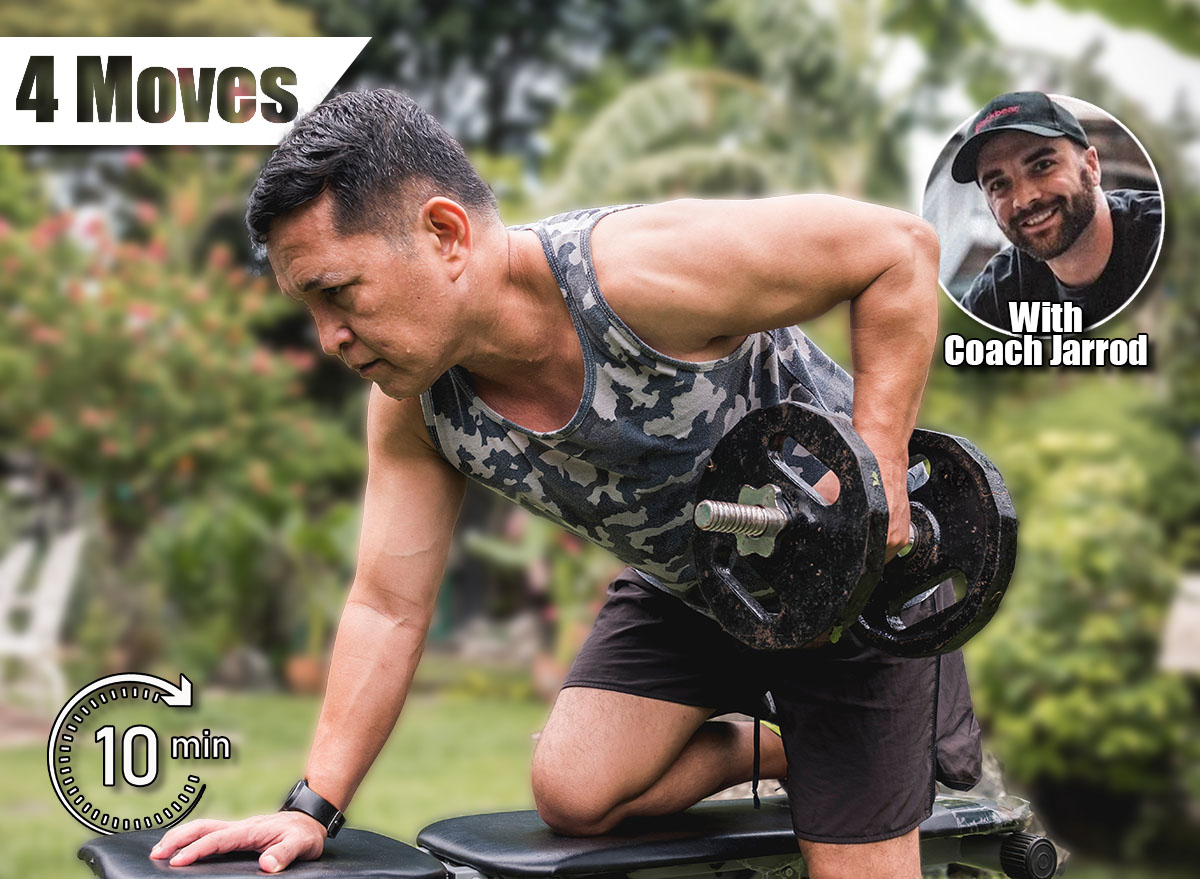
Aging brings wisdom, experience, and perspective. It also brings changes to your body that you can’t ignore. After 50, muscle mass naturally declines, bones lose density, and recovery takes longer than it used to. Without a plan to maintain strength, these changes can snowball into weakness, frailty, and a loss of independence down the road. That’s why strength training must be a vital tool for staying capable and resilient.
Building and maintaining strength pays off in more ways than just lifting heavier weights. It keeps your joints healthy, protects against injuries, and supports better balance and stability. It even plays a role in boosting your metabolism and helping you manage your weight. Strong muscles make everyday activities, like carrying groceries, playing with grandkids, and doing house projects, feel easy instead of exhausting. In short, strength training keeps you doing the things that make life meaningful.
It also supports longevity in ways you may not expect. Research consistently links strength training to a longer, healthier life. It reduces the risk of falls, helps manage chronic conditions like diabetes and heart disease, and improves mental health. The ability to move well, get up off the floor, or handle unexpected physical challenges is a form of insurance for your future. Training your body today gives you more freedom tomorrow.
If you’re wondering where to start, I’ve got you covered. The following four moves are my go-to recommendations for men over 50 who want to improve strength, protect their joints, and feel more capable in everyday life. They train multiple muscle groups at once, build functional strength, and can be adjusted to match your current fitness level. Let’s break them down.
4 Strength Moves Every Man Over 50 Should Do
Strength Move #1: Lunges
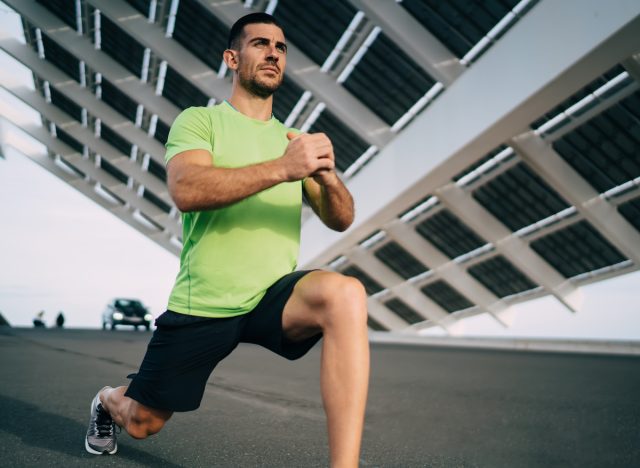
Here’s the thing about lunges: they make your legs stronger and more athletic. When I coach men over 50, I see how much their balance and hip stability improve once we start adding lunges regularly. They force each side of your body to pull its weight, literally, and that pays off when you’re climbing stairs, stepping off a curb, or carrying groceries across the driveway.
Muscles Trained: Quadriceps, hamstrings, glutes, calves, core.
How to Do It:
- Stand tall with your feet hip-width apart and your hands at your sides.
- Step one foot forward and lower your body until both knees bend at about 90 degrees.
- Keep your chest upright and your front knee stacked over your ankle.
- Push through your front heel to return to the starting position.
- Alternate legs and repeat for the desired number of reps.
Recommended Sets and Reps: Perform 3 sets of 10 to 12 reps per leg. Rest 45 to 60 seconds between sets.
Best Variations: Reverse lunges, walking lunges, Bulgarian split squats.
Form Tip: Keep your weight in your front heel and avoid letting your front knee cave inward.
Strength Move #2: Dumbbell Rows
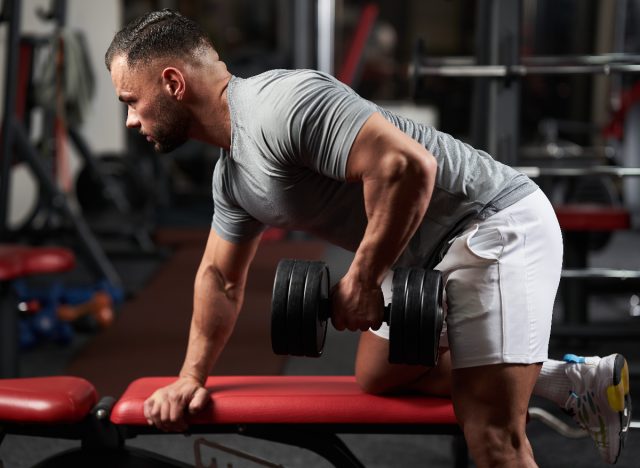
This is one of those moves I always program because it fixes a lot of problems at once. Too many guys let their upper back weaken and their shoulders roll forward with age—it’s a recipe for neck pain, poor posture, and limited mobility. Rows are my go-to for pulling everything back into alignment. You’ll feel your back get stronger, but you’ll also notice you stand taller without even trying.
Muscles Trained: Latissimus dorsi, rhomboids, trapezius, biceps, core
How to Do It:
- Hold a dumbbell in your right hand and place your left hand and left knee on a bench for support.
- Keep your back flat and core engaged as you let the dumbbell hang toward the floor.
- Pull the dumbbell toward your rib cage, keeping your elbow close to your body.
- Pause briefly at the top, then slowly lower the weight back down.
- Complete all reps on one side before switching to the other.
Recommended Sets and Reps: Perform 3 sets of 10 to 12 reps per side. Rest 45 to 60 seconds between sets.
Best Variations: Single-arm dumbbell row, Single-arm cable rows, two-dumbbell bent-over rows, renegade rows, barbell rows, chest-supported dumbbell rows.
Form Tip: Keep your torso stable and avoid twisting as you lift the weight.
Strength Move #3: Push-Ups
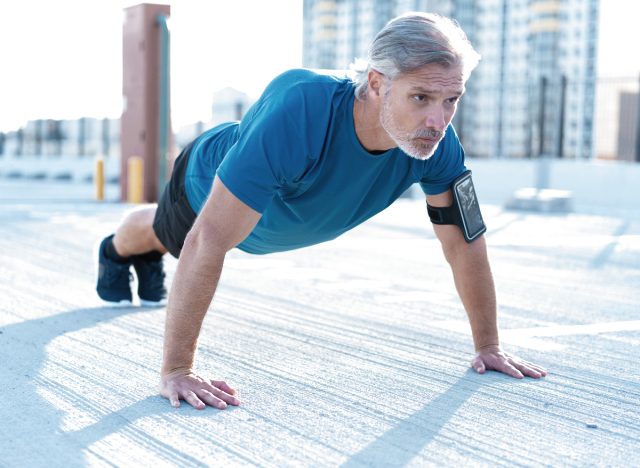
Push-ups have been around forever, and there’s a reason for that. When I train clients over 50, I love seeing how much stronger and more confident they get when they can knock out clean, controlled push-ups. They build pressing strength without the need for heavy weights, they keep your shoulders moving well, and they give you an easy way to track progress anywhere, even in your living room.
Muscles Trained: Chest, shoulders, triceps, core.
How to Do It:
- Place your hands slightly wider than shoulder-width apart on the floor.
- Extend your legs behind you and keep your body in a straight line from head to heels.
- Lower your chest toward the floor by bending your elbows.
- Push through your palms to return to the starting position.
- Maintain a tight core and steady breathing throughout.
Recommended Sets and Reps: Perform 3 sets of 8 to 15 reps. Rest 45 to 60 seconds between sets.
Best Variations: Incline push-ups, decline push-ups, push-ups with shoulder taps, elevated push-ups, TRX push-ups.
Form Tip: Keep your elbows at about a 45-degree angle to your body to protect your shoulders.
Strength Move #4: Dead Bug
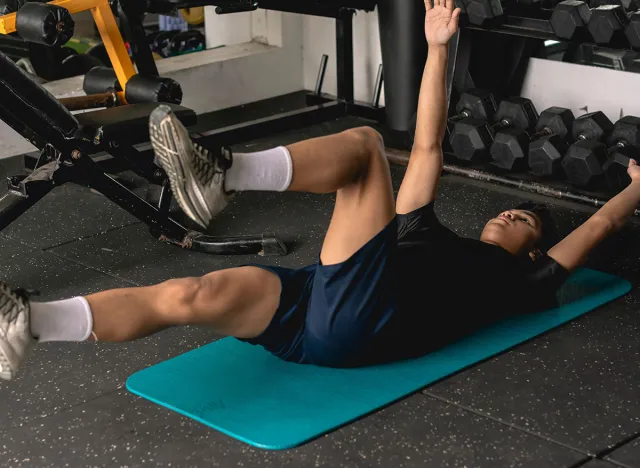
This one surprises people, but the dead bug is one of my favorite core exercises—especially for men over 50. I’ve seen it transform the way my clients move. It teaches you how to brace your core without stressing your back, which is a game-changer for lifting safely and keeping your spine protected. A strong core like this makes every other exercise you do better.
Muscles Trained: Rectus abdominis, transverse abdominis, hip flexors, lower back.
How to Do It:
- Lie on your back with your arms extended toward the ceiling and your knees bent at 90 degrees.
- Engage your core and flatten your lower back against the floor.
- Slowly lower your right arm and left leg toward the floor without arching your back.
- Return to the starting position, then repeat with the opposite arm and leg.
- Move slowly and maintain control throughout the exercise.
Recommended Sets and Reps: Perform 3 sets of 10 to 12 reps per side. Rest 30 to 45 seconds between sets.
Best Variations: Weighted dead bugs, stability ball dead bugs, band pullover dead bugs, dead bug crunches.
Form Tip: Keep your lower back pressed firmly into the floor during each rep.
The Best Ways to Increase Strength After 50 for Men
Strength training after 50 requires a thoughtful approach. Your body may need more recovery, but that doesn’t mean progress is out of reach. With the right strategy, you can keep building strength and protecting your longevity.
- Prioritize compound movements: Focus on exercises that train multiple muscle groups at once, like squats, rows, and presses.
- Train consistently: Aim for at least two to three strength sessions each week to maintain and build muscle.
- Don’t skip recovery: Prioritize rest days, quality sleep, and mobility work to help your body repair and perform better.
- Progress gradually: Increase weight, reps, or sets over time to keep challenging your muscles.
- Focus on form: Proper technique reduces injury risk and ensures you’re targeting the right muscles.
Looking for more easy ways to lose fat? Here’s How Long Your Walking Workout Should Be To Shrink Belly Fat.
References
- Burtscher, Johannes et al. “How much resistance exercise is beneficial for healthy aging and longevity?.” Journal of sport and health science vol. 12,3 (2023): 284-286. doi:10.1016/j.jshs.2022.11.004